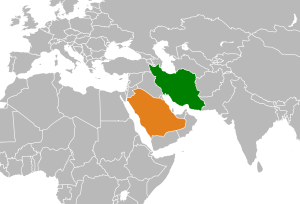A Region Divided: How Saudi Arabia and Iran are Shaping the Future of the Middle East
 The Middle East has historically been a paradigm of shifting power struggles and interchanging rivalries, interceded with the prolonged hegemony of the Ottoman Empire. Today, the conflict revolves primarily around Iran and Saudi Arabia, each respectively acting as proxies for Russia and the U.S. in a regional struggle that has taken on international dimensions.
The Middle East has historically been a paradigm of shifting power struggles and interchanging rivalries, interceded with the prolonged hegemony of the Ottoman Empire. Today, the conflict revolves primarily around Iran and Saudi Arabia, each respectively acting as proxies for Russia and the U.S. in a regional struggle that has taken on international dimensions.
The animosity between the two countries is not new, stemming from religious differences that follow a millennium-and-a-half-old sectarian line that divides the Muslim community in half. Though, the majority of Middle Eastern conflicts can be traced through this separation between Sunnis and Shiites, outward appearances of sectarianism often belie strategic considerations. In the case of Iran and Saudi Arabia, tensions revolve around a desire to gain the upper hand in the regional struggle for hegemony.
Yemen, Iraq, and Syria are all in the midst of a power struggle that is proving to be catastrophically divisive, at a time when unity seems likely to provide the best pathway to navigate the challenges that the region faces. An uprising of rebels allied to Iran in Yemen prompted an ongoing Saudi-led intervention in March of this year. In Iraq, Iranian militias are supporting Iraqi troops in the conflict against the group known as the Islamic State. Funding and weaponry are flowing into Syria, with the Saudis and Iranians backing two opposing sides in the bloody civil war.
Recent developments have added layers of complexity to an already complex relationship. The Hajj stampede this September in Saudi Arabia, in which at least 2,070 pilgrims died in the chaos of a panicked crowd, 465 of which are believed to be Iranian, has led to intense criticism of Saudi authorities by Iranian officials.
The latest confrontation developed following meetings in Vienna, where representatives from various countries had gathered to discuss the ongoing conflict in Syria. Iran, as a longtime supporter of Bashar al-Assad, argued that the current Syrian president should remain in power, or at least remain an actor in a political transition. Saudi Arabia argued for the opposite, stating that Assad cannot remain in his current position.
Positive developments in the relationship between Iran and Saudi Arabia are few. The election of Iranian President Hassan Rouhani in 2013, led many to hope that friendly ties would develop between the two states since Rouhani represented a more moderate strand of Iranian politics. Rouhani strengthened those hopes by actively attempting to improve diplomatic ties with the Saudis.
“I believe that our relations with Saudi Arabia should expand as we consider Saudi Arabia as an extremely important country in the region and the Islamic world,” Iranian Foreign Minister Mohammad Zarif said shortly after Rouhani’s election. “We believe that Iran and Saudi Arabia should work together in order to promote peace and stability in the region,” he added.
Iranian diplomatic overtures were not reciprocated by Saudi Arabia at the time and as of yet, Rouhani’s initial moderate stance has not lead to any constructive dialogue. The signing of the recent Iranian nuclear deal will impact the bilateral relationship, and Saudi Arabia has expressed hope that Iran will use the additional funds it will receive from the removal of sanctions for economic development. The deal is expected to boost Iran’s position in the region, a factor that will likely increase Saudi Arabian resentment.
